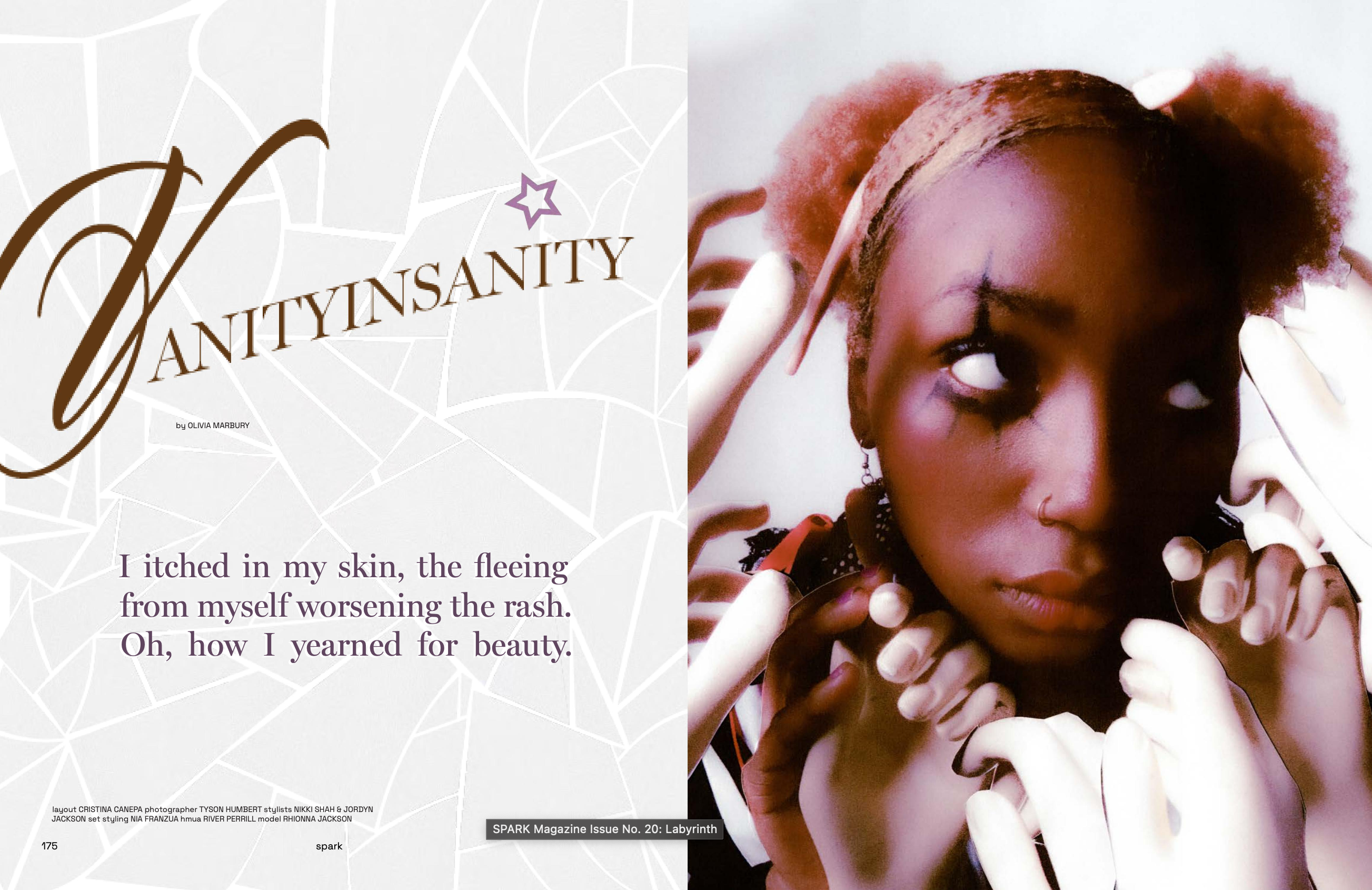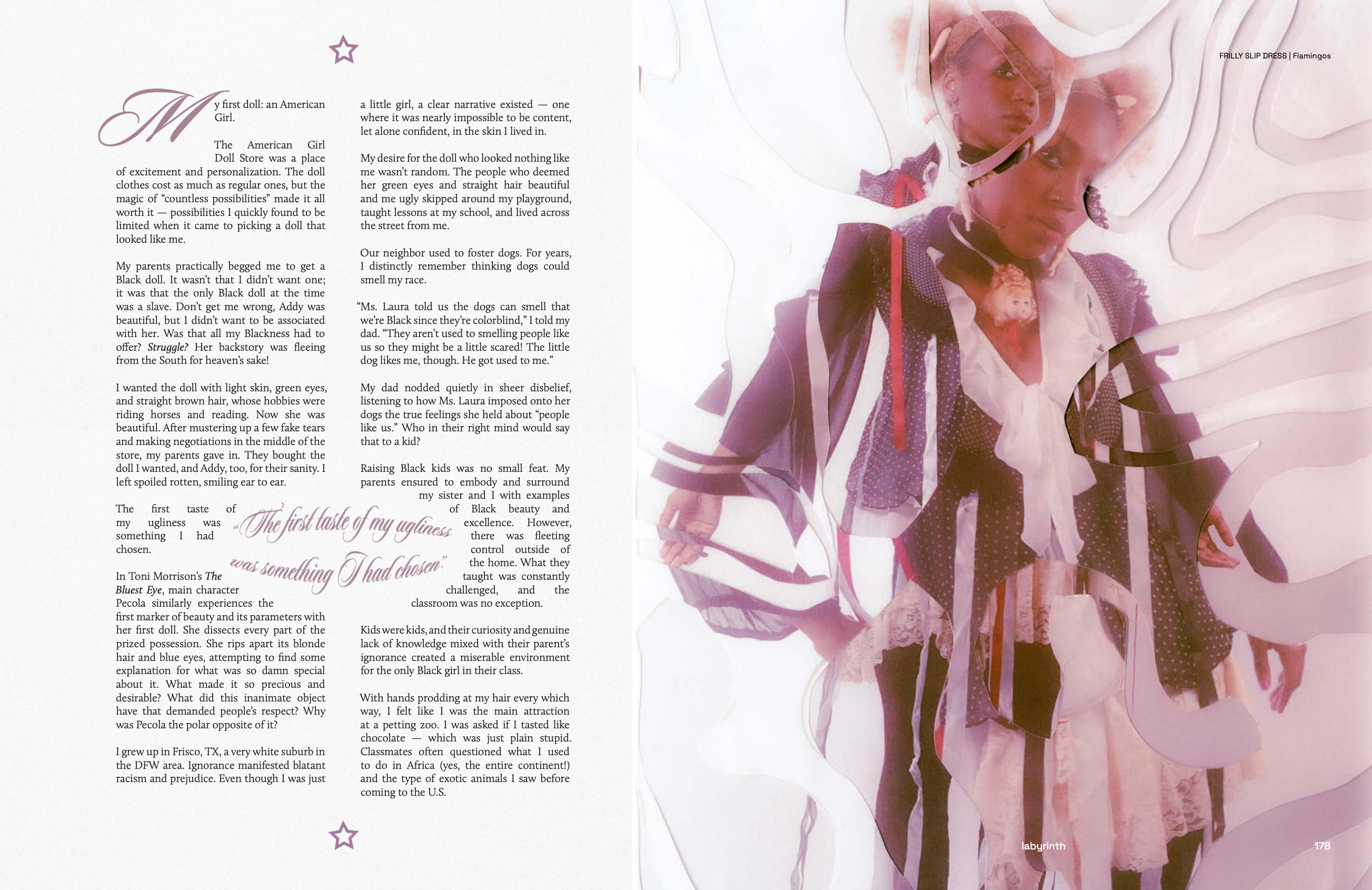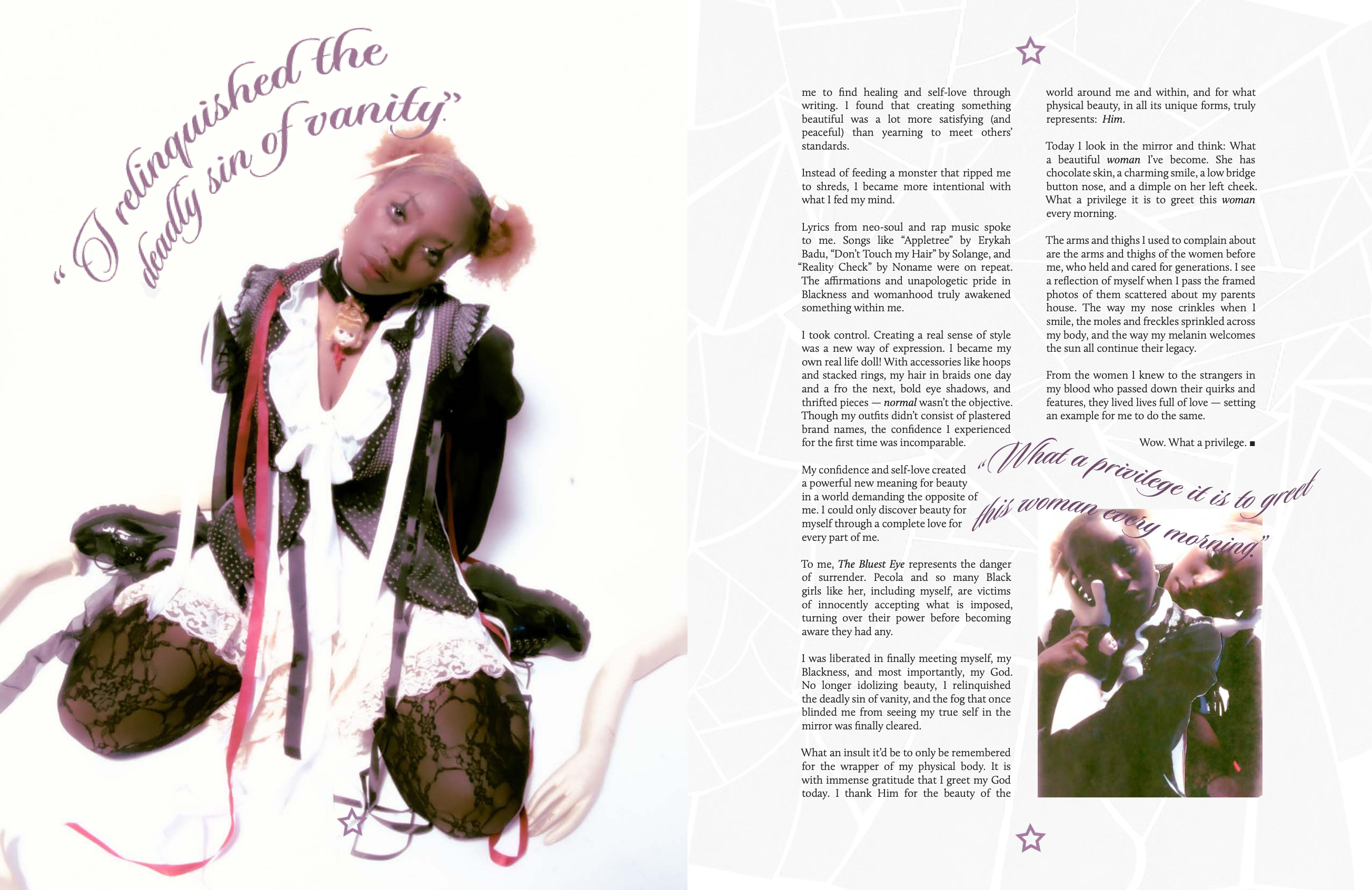VANITYINSANITY

| My reflection repulsed me because it made the world around me uncomfortable. I itched in my skin, the fleeing from myself worsening the rash. Oh, how I yearned for beauty. |
My first doll: an American Girl.
The American Girl Doll Store was a place of excitement and personalization. The doll clothes cost as much as regular ones, but the magic of “countless possibilities” made it all worth it — possibilities I quickly found to be limited when it came to picking a doll that looked like me.
My parents practically begged me to get a Black doll. It wasn’t that I didn’t want one; it was that the only Black doll at the time was a slave. Don’t get me wrong, Addy was beautiful, but I didn’t want to be associated with her. Was that all my Blackness had to offer? Struggle? Her backstory was fleeing from the South for heaven's sake!
I wanted the doll with light skin, green eyes, and straight brown hair, whose hobbies were riding horses and reading. Now she was beautiful. After mustering up a few fake tears and making negotiations in the middle of the store, my parents gave in. They bought the doll I wanted and Addy, too, for their sanity. I left spoiled rotten, smiling ear to ear.
The first taste of my ugliness was something I had chosen.

In Toni Morrison’s The Bluest Eye, main character Pecola similarly experiences the first marker of beauty and its parameters with her first doll. She dissects every part of the prized possession. She rips apart its blonde hair and blue eyes, attempting to find some explanation for what was so damn special about it. What made it so precious and desirable? What did this inanimate object have that demanded people's respect? Why was Pecola the polar opposite of it?
I grew up in Frisco, TX, a very white suburb in the DFW area. Ignorance manifested blatant racism and prejudice. Even though I was just a little girl, a clear narrative existed — one where it was nearly impossible to be content, let alone confident, in the skin I lived in.
My desire for the doll who looked nothing like me wasn’t random. The people who deemed her green eyes and straight hair beautiful and me ugly skipped around my playground, taught lessons at my school, and lived across the street from me.
Our neighbor used to foster dogs. For years, I distinctly remember thinking dogs could smell my race.
“Ms. Laura told us the dogs can smell that we’re Black since they’re colorblind,” I told my dad. “They aren’t used to smelling people like us so they might be a little scared! The little dog likes me, though. He got used to me.”
My dad nodded quietly in sheer disbelief, listening to how Ms. Laura imposed onto her dogs the true feelings she held about “people like us.” Who in their right mind would say that to a kid?
Raising Black kids was no small feat. My parents ensured to embody and surround my sister and I with examples of Black beauty and excellence. However, there was fleeting control outside of the home. What they taught was constantly challenged, and the classroom was no exception.
Kids were kids, and their curiosity and genuine lack of knowledge mixed with their parent’s ignorance created a miserable environment for the only Black girl in their class.
With hands prodding at my hair every which way, I felt like I was the main attraction at a petting zoo. I was asked if I tasted like chocolate — which was just plain stupid. Classmates often questioned what I used to do in Africa (yes, the entire continent!) and the type of exotic animals I saw before coming to the U.S.
Nerves took hold of my spine every time I had to walk into class knowing the curriculum at some point had to cover Black history. My teachers would nonchalantly flip through slides of Black pain, concluding that racism was no longer an issue because Harriet and Lincoln freed all of the slaves.
Anything that could possibly represent me came from a source of fear and ignorance. Their version of my history lacked color and life. It seemed as though beauty wasn’t even a possibility.
I felt like a mystical figure amongst the community that was supposed to be mine. I knew no different — it was my home — but different was all they saw in me. They’d only heard of, read about, or seen people like me in the news. I didn’t actually exist to them. And even more so, I was never a child in their eyes.
Innocence was a privilege. All I wanted to do was hide. I’d do anything to conceal the expression of my melanin in order to be viewed as what I was: just a kid.
I read The Bluest Eye for the first time in middle school after hearing about Toni Morrison. At that time, I found Pecola’s prayers for blue eyes fully justified. I felt as though assimilation was a given. Who wouldn’t want to be like them?
I prayed to the God I was introduced to and questioned Him on how He chose to reflect His image upon me. I accepted what I was told: That I was made in His image and perfection only lay in Him. But I yearned for perfection and beauty in every facet of life, and when I looked in the mirror as a child I felt deficient in both. How could His grace pass me by?

My disdain for something that was such a huge part of me led to an attempt to silently assimilate. I felt my ugliness like a paralyzing crick in my neck. From the minute I woke up to the time my head hit the pillow, I was stiffened with insecurity.
I succeeded in blending in by being quiet and playing dress-up: Sperry, Abercombie & Fitch, Hollister, and Justice pieces filled my closet. I listened to anything within the Pop genre, screaming Taylor Swift lyrics even though I found them painfully unrelatable and dramatic.
I was the carbon copy of a typical pre-teen girl and it was actually ugly — not because there was anything inherently wrong with beauty or the interests of those around me, but because I was obsessed with the desire to be perceived as conventionally beautiful. The cost of joy and individuality was a small price to pay for normal — until it wasn’t.
Through Black art and literature, I discovered beauty with a depth that could only be found in Blackness and the stories behind it.
Authors like Toni Morrison took the blood from her wounds and struggles and created murals. She articulated what it means to be a Black woman in such a poetic way, inspiring me to find healing and self-love through writing. I found that creating something beautiful was a lot more satisfying (and peaceful) than yearning to meet others’ standards.
Instead of feeding a monster that ripped me to shreds, I became more intentional with what I fed my mind.
Lyrics from neo-soul and rap music spoke to me. Songs like Appletree by Erykah Badu, Don’t Touch my Hair by Solange, and Reality Check by Noname were on repeat. The affirmations and unapologetic pride in Blackness and womanhood truly awakened something within me.
I took control. Creating a real sense of style was a new way of expression. I became my own real life doll! With accessories like hoops and stacked rings, my hair in braids one day and a fro the next, bold eye shadows, and thrifted pieces — normal wasn’t the objective. Though my outfits didn’t consist of plastered brand names, the confidence I experienced for the first time was incomparable.
My confidence and self-love created a powerful new meaning for beauty in a world demanding the opposite of me. I could only discover beauty for myself through a complete love for every part of me.

To me, The Bluest Eye represents the danger of surrender. Pecola and so many Black girls like her, including myself, are victims of innocently accepting what is imposed, turning over their power before becoming aware they had any.
I was liberated in finally meeting myself, my Blackness, and most importantly, my God. No longer idolizing beauty, I relinquished the deadly sin of vanity, and the fog that once blinded me from seeing my true self in the mirror was finally cleared.
What an insult it’d be to only be remembered for the wrapper of my physical body. It is with immense gratitude that I greet my God today. I thank Him for the beauty of the world around me and within, and for what physical beauty, in all its unique forms, truly represents: Him.
Today I look in the mirror and think: What a beautiful woman I’ve become. She has chocolate skin, a charming smile, a low bridge button nose, and a dimple on her left cheek. What a privilege it is to greet this woman every morning.
The arms and thighs I used to complain about are the arms and thighs of the women before me, who held and cared for generations. I see a reflection of myself when I pass the framed photos of them scattered about my parents house. The way my nose crinkles when I smile, the moles and freckles sprinkled across my body, and the way my melanin welcomes the sun all continue their legacy.
From the women I knew to the strangers in my blood who passed down their quirks and features, they lived lives full of love — setting an example for me to do the same.
Wow. What a privilege. ■
Layout: Cristina Canepa
Photographer: Tyson Humbert
Stylists: Nikki Shah & Jordyn Jackson
Set Stylist: Nia Franzua
HMUA: River Perrill
Model: Rhionna Jackson
Other Stories in Labyrinth
© 2024 SPARK. All Rights Reserved.
